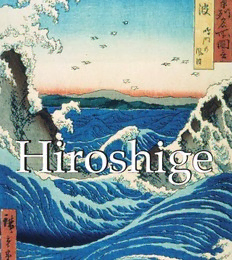
Hiroshige PDF
Preview Hiroshige
HHHiiirrrooossshhhiiigggeee Text: Michail Uspensky Translation: Paul Williams Page 4: The Suidobashi Bridge and Surugadai (Sudoibashi Surugadai), May 1857. Colour woodblock print, 36 x 24 cm. Gift of Anna Ferris, Brooklyn Museum of Art, New York. Designed by: Baseline Co Ltd 127-129A Nguyen Hue Bld Fiditourist, 3rdFloor District 1, Ho Chi Minh City Vietnam © Sirrocco, London, UK © Confidential Concepts, Worldwide, USA All rights reserved. No part of this publication may be reproduced or adapted without the permission of the copyright holder throughout the world. Unless otherwise specified, copyright on the works reproduced lies with the respective photographers. Despite intensive research, it has not always been possible to establish copyright ownership. Where this is the case, we would appreciate notification. ISBN : 978-1-78042-183-4 2 FFoorreewwoorrdd “Dropping my brush at Azuma [Eastern Capital] I go a journey to the honourable country in the west [the Buddhist Paradise is supposed to be in the west] to view the wonderful sights there.” — Hiroshige’s death-song which he wrote on a piece of paper. 3 4 BBiiooggrraapphhyy 1797: Ando Hiroshige was born under the name of Ando Tokutaro. He was the son of the warden of the fire brigade assigned to the Edo Castle. Various episodes indicate that the young Hiroshige was fond of sketching and it is most likely that a fireman, who had studied under a master of the traditional Kano school of painting, oversaw his tutelage. 1809: His mother died. Shortly after, his father resigned his post, passing it on to his son. Early the following year, his father died as well. Hiroshige’s actual daily duties as a fire warden were minimal, and his wages were small. 1811: At the age of fourteen, the young Hiroshige had the chance to join the famous Utagawa painting school and became a pupil of Utagawa Toyohiro, a famous Japanese ukiyo-e artist. 1812: He obtained a school license and was rewarded with the name Utagawa Hiroshige. In the ukiyo-e literature he is usually referenced as Hiroshige Ando. 1818: His first published work appeared. 5 6 1830s: Hiroshige did not immediately begin to produce landscape prints. His main output consisted of prints of beautiful women (bijinga) and actors (yakushae). He gradually gave up figure prints for landscapes. He started, under the influence of the great Hokusai, the series that made him famous. 1832: He traveled between Edo and Kyoto along the famed highway called the Tokaido; he stayed at the 53 overnight stations along the road and made numerous sketches of everything he saw. He published a series of 55 landscape prints entitled the “Fifty-three Stations on the Tokaido” - one for each station, as well as the beginning of the highway and the arrival in Kyoto. The success of this series was immediate and made Hiroshige one of the most popular ukiyo-e artists of all time. 1850s: Some vertical-format compilations of landscape prints date from this period such as “Famous Places in Kyoto” (1834), “Eight Views of Lake Biwa” (1835), “Sixty-nine Stations on the Kiso Highway” (c. 1837), and “One Hundred Famous Views of Edo” (1856-58). 1858: Hiroshige died of cholera and was buried in a Zen temple in Asakusa, Tokyo. 7 Between the seventeenth and nineteenth centuries in Japan, the Edo period (1603-1868), a new tendency in urban art developed and it is to this style, known as ukiyo-e, literally “pictures of the floating world”, that the woodblock print belongs. Ando Hiroshige is quite possibly the most famous Japanese print artist beyond his native shores. In 1811 he joined the pupils of one of the prominent print artists of the day, Utagawa Toyohiro. From the turn of the 1830s, Hiroshige’s thoughts were more and more concentrated on the landscape, which subsequently became the chief theme of his Peach, Plum, Chrysanthemum, a Monkey, and Chickens From the series Shellwork from an exhibition at Okuyama in Asakusa 1820 Colour woodblock print, 38 x 25.5 cm Victoria and Albert Museum, London 8 9 creative work. Over the course of more than twenty years, the artist produced several series of prints, which demonstrated most vividly his talent in that sphere of art. In the 1850s Hiroshige’s work underwent a radical change: the earlier smooth narrative manner gave way to abrupt compositional and chromatic contrasts. Hiroshige’s landscapes represented a new and final stage of development in the ukiyo-e landscape print and, more broadly, in the traditional art of Japan. For him, there were no vulgar objects, and in his work any landscape motif reflected in human perception is a means of penetrating the essence of nature, its spirit. Kanbara, from the series “Fifty-three stages of the Kisokaido” Tokaido gojusan-tsugi: Kanbara 1835-42 Brocade print, 38 x 25.5 cm Tokyo National Museum, Tokyo 10
